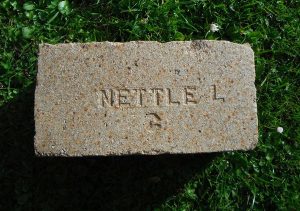(Note – SBH – I am unsure if the references below all refer to the same mine or several mines in the same area. It is often difficult to differentiate between clay mine references and to whether they relate to the Weir Castlecary Works or the Stein Castlecary Works. This page hopefully, just records those related to the Stein Castlecary Works).
This mine was sunk to supply the Stein Castlecary Fireclay Works with high alumina grade clay. (Thistle fireclay). Silica clay was also found and this was used to manufacture silica-based firebricks.
27/07/1901 – Kirkintilloch Gazette – At Castlecary Clay Pit a new shank is at present being sunk and for the next few weeks the clay required to keep the fireclay works in full swing will be obtained from a mine along the banks of the Red Burn, to the south of the Castlecary road. The raw material is being driven to the works, the contract for the carting being in the hands of Mr John Anthony, Kilsyth. The alterations, it is expected, will cost £1000.
20/04/1903 – Work starts on the mine.
04/11/1903 – Clay was reached and a further return airway shaft was dug and this took 7 months.
c. 06/1903 – Clay was being mined.
23/11/1909 – The Scotsman – Pit engineman’s neglect of duty. In Falkirk Sheriff Court yesterday, Sheriff Moffat heard evidence in a charge against Hugh Wren, engineman, Bonnybridge who was alleged to have contravened the mining regulations at Clay Pit No. 1, Castlecary, belonging to John G. Stein & Co, by failing, on 4th October last to signal to the pit bottom intelligence of the fact that the gate at the mid-working was open. The case was a sequel to an accident that occurred on the date in question when a pit bottomer fell down the shaft from the mid-working and was killed. The defence was that it was impossible for the accused to make the necessary signal through all his attention being directed to the engine brake, which was alleged to be defective. After hearing the evidence, the Sheriff said the fact that the engineman did not signal in accordance with the regulations was prima facia evidence of a breach of the regulations. He thought the onus was upon the accused to prove that he could not conform, to the rule, and he (the Sheriff ) was not satisfied that it was impossible for him to perform the duty laid upon him of giving the signal. A fine of 20s was imposed and an appeal was intimated.
17/07/1926 – Falkirk Herald – On Monday a partial resumption of work took place in Messrs J. G. Stein’s Castlecary clay pit. Work in this pit had been stopped since the commencement of the mining dispute, owing to lack of coal, but supplies of foreign coal have been received. Twenty-six men commenced Monday, and more started on Tuesday.
11/10/1941 – Falkirk Herald – Fatal accident. Last Saturday morning a 59-year-old clay-miner named John Bullions, lost his life in a distressing accident at Castlecary. Deceased, who resided with his niece, Mrs Walker, at Main Street, Longcraft, was employed as a repairer in the Castlecary clay-pit of the General Refractories Company, Ltd., and was following his regular occupation when there was an unexpected fall of material from the side-wall of the working. Bullions received severe head injuries, from which he succumbed shortly afterwards.
22/02/1947 – Falkirk Herald – Wanted for fireclay pit. mining experience not essential, six weeks training given on trade union wages; after training, energetic men can earn good wages piecework. John G Stein & Co., Ltd, Castlecary Works, Bonnybridge.
28/05/1955 – Falkirk Herald – John George Fulton (55), 219a Kilsyth Road, Banknock employed as a winding engineman at the Castlecary clay pit, collapsed beside his engine at 11.30 a.m. on Monday. He received immediate attention, but it was found that he had died from natural causes










